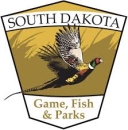This project will construct two rock-arch fishways at a flood diversion barrier on the Little Minnesota River in South Dakota. Restored connectivity between the Little Minnesota River, its tributaries, and Bigston Lake will benefit at least 40 species of native fish and freshwater mussels including lake sturgeon and walleye, an important subsistence species to the Sisseton-Wahpeton Oyate Tribe. These fishways will allow for fish passage fish passage
Fish passage is the ability of fish or other aquatic species to move freely throughout their life to find food, reproduce, and complete their natural migration cycles. Millions of barriers to fish passage across the country are fragmenting habitat and leading to species declines. The U.S. Fish and Wildlife Service's National Fish Passage Program is working to reconnect watersheds to benefit both wildlife and people.
Learn more about fish passage while also continuing to protect nearby communities from floods and changes to flooding with climate change climate change
Climate change includes both global warming driven by human-induced emissions of greenhouse gases and the resulting large-scale shifts in weather patterns. Though there have been previous periods of climatic change, since the mid-20th century humans have had an unprecedented impact on Earth's climate system and caused change on a global scale.
Learn more about climate change . Historically, the migration of fish upstream sustained the Sisseton band of the Dakota during the spring months through annual spearfishing events. Within the last decade, fish migration has ceased, and completion of this project will bring fish back to the reservation and spearing grounds.
Project Quick Facts:
Project Status | In Development |
Location | SD, Roberts County |
NFPP Project Funding | $250,000 |
Restoration Techniques | Fishway Construction |
Accomplishments | 75 Stream Miles Reopened |
Partner Project Lead | South Dakota Game, Fish, and Parks |
The National Fish Passage Program: Leaders in Building Bridges and Fostering Connections
The National Fish Passage Program is a national leader connecting watersheds and people. The program has decades of experience implementing infrastructure projects with partners. Fish passage project proposals can be initiated by any individual, organization, government, or agency. However, proposals must be submitted and completed in cooperation with a Fish and Wildlife Conservation Office. (Please note that fish passage projects being used for federal or state compensatory mitigation or required by existing federal or state regulatory programs are not eligible for funding through the National Fish Passage Program.)
CONTACT A FISH PASSAGE COORDINATOR IN YOUR AREA TO GET STARTED.
200 Million Dollar Investment in Rivers, Wildlife, and Communities
Clean free-flowing waterways are vital to wildlife, people, and ecosystems. But across the country, millions of barriers fragment rivers, block fish migration, and put communities at higher risk to flooding. The Bipartisan Infrastructure Law Bipartisan Infrastructure Law
The Bipartisan Infrastructure Law (BIL) is a once-in-a-generation investment in the nation’s infrastructure and economic competitiveness. We were directly appropriated $455 million over five years in BIL funds for programs related to the President’s America the Beautiful initiative.
Learn more about Bipartisan Infrastructure Law , signed in November 2021, included $200 million for restoring fish and wildlife passage by removing in-stream barriers and providing technical assistance under the National Fish Passage Program.


